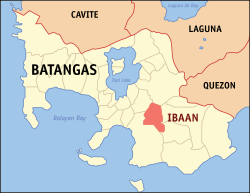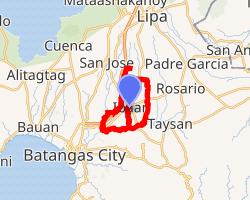Ibaan
Ibaan, officially the Municipality of Ibaan (Tagalog: Bayan ng Ibaan), is a 2nd class municipality in the province of Batangas, Philippines. According to the 2015 census, it had a population of 52,970 people.[3]
Ibaan | |
|---|---|
| Municipality of Ibaan | |
Seal | |
 Map of Batangas with Ibaan highlighted | |
OpenStreetMap 
| |
.svg.png) Ibaan Location within the Philippines | |
| Coordinates: 13°49′03″N 121°07′59″E | |
| Country | |
| Region | Calabarzon (Region IV-A) |
| Province | Batangas |
| District | 4th District |
| Founded | February 11, 1832 |
| Barangays | 26 (see Barangays) |
| Government | |
| • Type | Sangguniang Bayan |
| • Mayor | Edralyn Joy A. Salvame |
| • Vice Mayor | Socrates R. Arellano |
| • Congressman | Lianda B. Bolilia |
| • Electorate | 39,513 voters (2019) |
| Area | |
| • Total | 68.99 km2 (26.64 sq mi) |
| Population (2015 census)[3] | |
| • Total | 52,970 |
| • Density | 770/km2 (2,000/sq mi) |
| • Households | 12,005 |
| Economy | |
| • Income class | 2nd municipal income class |
| • Poverty incidence | 7.2% (2015)[4] |
| • Revenue (₱) | 122,147,502.81 (2016) |
| Time zone | UTC+8 (PST) |
| ZIP code | 4230 |
| PSGC | |
| IDD : area code | +63 (0)43 |
| Climate type | tropical monsoon climate |
| Native languages | Tagalog |
| Website | www |
Ibaan is located 96 kilometres (60 mi) south of Manila. It is bounded on the northwest by San Jose, the northeast by Lipa City, the east by Rosario, the southeast by Taysan, and the southwest by Batangas City. It has a land area of 68.99 square kilometres (26.64 sq mi) at an altitude of 124 metres (407 ft) above sea level.
It is a predominantly Roman Catholic community, with small percentages of Protestants and members of the Iglesia ni Cristo. Tagalog is the local language in the Batangueño dialect; however, English is included in its educational curriculum and is often used in official dealings and transactions.
Temperature is moderate both in its rainy and dry seasons, conducive to farming, agricultural and livestock production, which are the most common occupations. There are fewer farmers each year as residents switch to hog-raising, which provides better income.
Ibaan is known as the home of the "kulambo" (mosquito net), as its production and trading has become one of the most profitable businesses in the locality. Ibaan is also known for its tamales that are wrapped in banana leaves.
The town celebrates its foundation day every February 11, with a simple festival called "Les Kuhliembo Festival", featuring their products: tamales, kulambo, habi, liempo, and tubo (sugar cane).
Geography
Ibaan is located at 13°49′03″N 121°07′59″E.
According to the Philippine Statistics Authority, the municipality has a land area of 68.99 square kilometres (26.64 sq mi) [2] constituting 2.21% of the 3,119.75-square-kilometre- (1,204.54 sq mi) total area of Batangas.
Barangays
Ibaan is politically subdivided into 26 barangays.[5] Bungahan was constituted as a barrio in 1956.[6]
| PSGC | Barangay | Population | ±% p.a. | |||
|---|---|---|---|---|---|---|
| 2015[3] | 2010[7] | |||||
| 041010001 | Bago | 3.9% | 2,047 | 1,985 | 0.59% | |
| 041010002 | Balanga | 3.6% | 1,883 | 1,781 | 1.07% | |
| 041010003 | Bungahan | 2.6% | 1,355 | 1,276 | 1.15% | |
| 041010004 | Calamias | 4.0% | 2,125 | 1,848 | 2.70% | |
| 041010005 | Catandala | 2.2% | 1,143 | 949 | 3.61% | |
| 041010006 | Coliat | 7.6% | 4,026 | 3,213 | 4.39% | |
| 041010007 | Dayapan | 1.6% | 841 | 733 | 2.65% | |
| 041010008 | Lapu‑lapu | 3.6% | 1,914 | 1,712 | 2.15% | |
| 041010009 | Lucsuhin | 2.8% | 1,508 | 1,510 | −0.03% | |
| 041010010 | Mabalor | 1.5% | 820 | 821 | −0.02% | |
| 041010011 | Malainin | 2.0% | 1,070 | 1,082 | −0.21% | |
| 041010012 | Matala | 6.0% | 3,178 | 3,083 | 0.58% | |
| 041010013 | Munting‑Tubig | 3.5% | 1,866 | 1,700 | 1.79% | |
| 041010014 | Palindan | 4.3% | 2,275 | 2,165 | 0.95% | |
| 041010015 | Pangao | 6.1% | 3,216 | 2,827 | 2.49% | |
| 041010016 | Panghayaan | 1.6% | 836 | 888 | −1.14% | |
| 041010017 | Poblacion | 5.1% | 2,711 | 2,518 | 1.42% | |
| 041010018 | Quilo | 3.2% | 1,699 | 1,556 | 1.69% | |
| 041010019 | Sabang | 3.4% | 1,820 | 1,802 | 0.19% | |
| 041010020 | Salaban I | 2.6% | 1,374 | 1,125 | 3.88% | |
| 041010022 | San Agustin | 4.3% | 2,259 | 2,070 | 1.68% | |
| 041010023 | Sandalan | 2.4% | 1,283 | 1,243 | 0.60% | |
| 041010024 | Santo Niño | 5.9% | 3,107 | 2,954 | 0.97% | |
| 041010025 | Talaibon | 7.4% | 3,902 | 3,376 | 2.80% | |
| 041010027 | Tulay na Patpat | 6.5% | 3,441 | 3,047 | 2.34% | |
| 041010028 | Salaban II | 2.4% | 1,271 | 1,218 | 0.81% | |
| Total | 52,970 | 48,482 | 1.70% | |||
Climate
| Climate data for Ibaan, Batangas | |||||||||||||
|---|---|---|---|---|---|---|---|---|---|---|---|---|---|
| Month | Jan | Feb | Mar | Apr | May | Jun | Jul | Aug | Sep | Oct | Nov | Dec | Year |
| Average high °C (°F) | 28 (82) |
29 (84) |
31 (88) |
32 (90) |
31 (88) |
30 (86) |
28 (82) |
28 (82) |
28 (82) |
28 (82) |
29 (84) |
28 (82) |
29 (84) |
| Average low °C (°F) | 19 (66) |
19 (66) |
20 (68) |
21 (70) |
23 (73) |
24 (75) |
23 (73) |
24 (75) |
23 (73) |
22 (72) |
21 (70) |
20 (68) |
22 (71) |
| Average precipitation mm (inches) | 11 (0.4) |
13 (0.5) |
14 (0.6) |
32 (1.3) |
101 (4.0) |
142 (5.6) |
208 (8.2) |
187 (7.4) |
175 (6.9) |
131 (5.2) |
68 (2.7) |
39 (1.5) |
1,121 (44.3) |
| Average rainy days | 5.2 | 5.0 | 7.4 | 11.5 | 19.8 | 23.5 | 27.0 | 25.9 | 25.2 | 23.2 | 15.5 | 8.3 | 197.5 |
| Source: Meteoblue (modeled/calculated data, not measured locally) [8] | |||||||||||||
Demographics
|
| ||||||||||||||||||||||||||||||||||||||||||||||||
| Source: Philippine Statistics Authority[3][7][9][10] | |||||||||||||||||||||||||||||||||||||||||||||||||
In the 2015 census, Ibaan had a population of 52,970.[3] The population density was 770 inhabitants per square kilometre (2,000/sq mi).
Religion
Ibaan is home to the Saint James the Greater Parish, the seat of the Roman Catholic in Ibaan, which is the oldest church in town.
The indigenous Iglesia ni Cristo has several locales in the town, including the chapels in Coliat and Matala.
Economy
Ibaan main products include tamales, kulambo (mosquito net), lomi, panutsa (sweet peanut), and sugarcane.
Culture
Festivals
Ibaan celebrates civic and national holidays. The Ibaan Foundation Day is celebrated every December to commemorate the city's founding. Each barangay also has its own festivity guided by their patron saint. The town is host to the Feast of Saint James the Greater, held every 25 July, which draws hundreds of Catholic devotees. Another religious feasts held in Ibaan was the Procession Feast of Holy week. Non-religious holidays include the New Year's Day, National Heroes' Day, Bonifacio Day, and Rizal Day.
Sports
Most barangays have a makeshift basketball court, with court markings drawn on the roads. Larger barangays have covered courts where interbarangay leagues are held every summer (April to May).
The town has several well-known sports venues, such as the Bro. Medrano Plaza and Recto Gymnasium, the home of the now defunct Ibaan Basketball Team. The Bro. Medrano Plaza, which houses the basketball and volleyball courts, had hosted several multi-sport events and games.
Other well-known sports facilities include the Recto Gym, operated by the local government, and the Fr. Guido Colletti Gym, a private venue owned by Saint James Academy.
Education
Elementary schools and high schools include.
- Dr. Juan A. Pastor Memorial National High School
- Maximo T. Hernandez Memorial National High School
- BUNGAHAN ELEMENTARY SCHOOL
- Balanga Elementary School
- Coliat Elementary School
- Ibaan Central School
- Lucsuhin Elementary School
- Mabalor-Catandala Elementary School
- Malainin Elementary School
- Munting Tubig Elementary School
- Palindan Elementary School
- Quilo Elementary School
- Sabang Elementary school
- San Agustin Elementary School
- Santo Niño Elementary School
- Talaibon Elementary School
- Tulay-Calamias Elementary School
Ibaan has private schools, mostly Catholic or Christian:
- Acts Christian Academy
- Ibaan Nazareth School
- Marfeben Academy
- Our Lady of Grace Formation School
- Saint James Academy
- Saint Jude School of Science and Technology
Gallery
- Municipal hall
- Downtown Ibaan
- B.R. Medrano Memorial Plaza
- Saint James the Greater Parish Church
References
- "Municipality". Quezon City, Philippines: Department of the Interior and Local Government. Retrieved 31 May 2013.
- "Province: Batangas". PSGC Interactive. Quezon City, Philippines: Philippine Statistics Authority. Retrieved 12 November 2016.
- Census of Population (2015). "Region IV-A (Calabarzon)". Total Population by Province, City, Municipality and Barangay. PSA. Retrieved 20 June 2016.
- "PSA releases the 2015 Municipal and City Level Poverty Estimates". Quezon City, Philippines. Retrieved 1 January 2020.
- "Municipal: Ibaan". PSGC Interactive. Quezon City, Philippines: Philippine Statistics Authority. Retrieved 8 January 2016.
- "An Act to Create the Barrio of Bungahan in the Municipality of Ibaan, Province of Batangas". LawPH.com. Retrieved 2011-04-12.
- Census of Population and Housing (2010). "Region IV-A (Calabarzon)". Total Population by Province, City, Municipality and Barangay. NSO. Retrieved 29 June 2016.
- "Ibaan: Average Temperatures and Rainfall". Meteoblue. Retrieved 5 May 2020.
- Censuses of Population (1903–2007). "Region IV-A (Calabarzon)". Table 1. Population Enumerated in Various Censuses by Province/Highly Urbanized City: 1903 to 2007. NSO.
- "Province of Batangas". Municipality Population Data. Local Water Utilities Administration Research Division. Retrieved 17 December 2016.
External links
| Wikimedia Commons has media related to Ibaan, Batangas. |